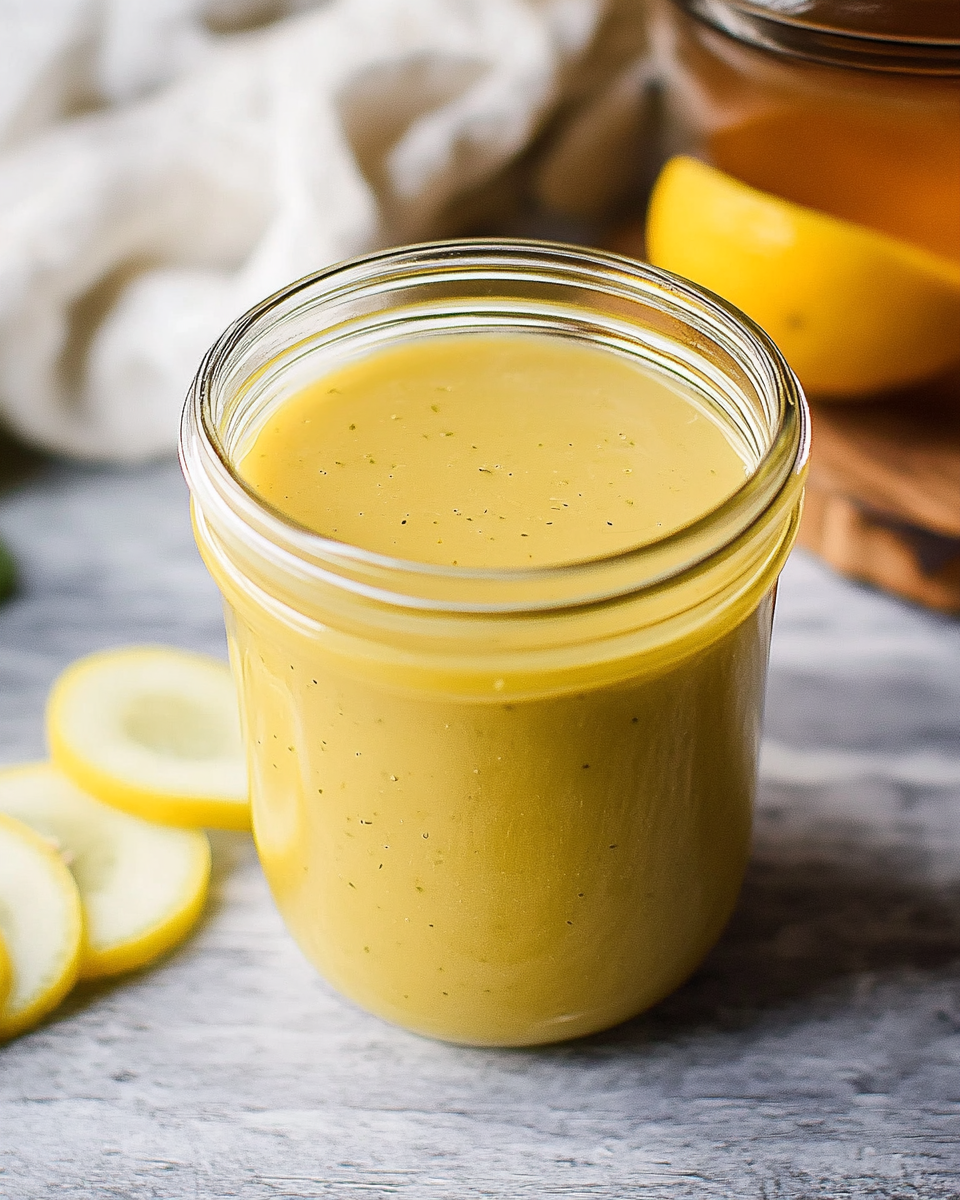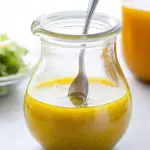A simple vinaigrette is a classic, tangy dressing made with a base of olive oil and vinegar, often combined with a touch of sweetness and Dijon mustard. It’s a light, zesty dressing that elevates salads, grains, and vegetables with minimal effort. Unlike store-bought versions that often contain preservatives, stabilizers, and unnecessary sugar, this homemade vinaigrette is clean, quick, and full of flavor.

This dressing is not just for salads. It’s also excellent for marinating proteins, adding flavor to grain bowls, or drizzling over roasted vegetables. The best part? It takes just five minutes to make with common pantry ingredients.
Why You’ll Love This Simple Vinaigrette
This vinaigrette recipe offers everything you need in a versatile homemade dressing:
- Fast and easy – No blender, food processor, or fancy tools needed.
- Clean and healthy – Made with whole food ingredients, no additives.
- Customizable – Adjust the tang, sweetness, or seasoning to your taste.
- Versatile – Works on salads, roasted vegetables, pasta salads, and more.
- Budget-friendly – Uses ingredients you likely already have.
If you’re looking for a flavorful, healthy, and endlessly adaptable dressing, this simple vinaigrette is the one to master.
Preparation Phase & Tools to Use
Crafting the ideal vinaigrette starts with quality ingredients and the right tools. While it’s simple, technique and equipment matter.
Essential Tools and Equipment
- Mason jar or any jar with a lid – Ideal for mixing and storing.
- Small whisk – Useful if you prefer to mix in a bowl.
- Measuring spoons and cups – Ensures balance in flavor.
- Rubber spatula – Helps scrape down bowls or jars completely.
Importance of Each Tool
- Jar with lid – Allows you to shake and emulsify without mess.
- Whisk – Perfect for smooth mixing if you don’t use a jar.
- Measuring tools – Maintains the correct oil-to-vinegar ratio.
- Spatula – Prevents ingredient waste and aids cleanup.
Preparation Tips
- Use room temperature ingredients for a smoother blend.
- Shake or whisk right before serving to keep the dressing emulsified.
- Adjust vinegar, oil, and sweetener to suit the dish you’re pairing it with.
- For extra depth, consider adding herbs or minced garlic.
Ingredients List
This basic vinaigrette includes six essential ingredients:
- ¼ cup extra virgin olive oil
- 2 tablespoons apple cider vinegar
- Substitute options: red wine vinegar, white wine vinegar, or balsamic vinegar
- 1½ teaspoons honey
- For vegan option: use maple syrup or agave nectar
- ½ teaspoon Dijon mustard
- ⅛ teaspoon kosher salt
- Or use fine sea salt if preferred
- Freshly ground black pepper, to taste
Ingredient Notes
- Use high-quality extra virgin olive oil for best flavor.
- The Dijon mustard not only adds tang, it also helps emulsify the vinaigrette.
- The sweetener (honey or maple syrup) balances the acidity and sharpness.
Step-by-Step Instructions
- Combine all ingredients in a jar with a tight-fitting lid or a small mixing bowl.
- If using a jar, seal the lid and shake vigorously for 30 seconds until emulsified.
- If using a bowl, whisk the mixture continuously until well blended and thickened.
- Taste the vinaigrette:
- Add more vinegar if you prefer it tangier.
- Add more oil to mellow out acidity.
- Adjust salt and pepper as needed.
- Use immediately or store in the refrigerator in a sealed jar for up to two weeks.
Variation Tips
- Swap apple cider vinegar for balsamic for a richer, slightly sweet profile.
- Add 1 teaspoon of minced shallot for extra depth.
- Include chopped fresh herbs like parsley or oregano for herbaceous flavor.
- Add a splash of lemon juice for a citrus twist.
Serving Suggestions
This simple vinaigrette is incredibly versatile. Its clean, balanced flavor profile pairs beautifully with a wide range of dishes. Here are several popular and creative ways to incorporate it into your meals:
Classic Salad Pairings
- Drizzle over mixed greens, cherry tomatoes, cucumbers, and red onions.
- Pair with a baby spinach salad topped with goat cheese and walnuts.
- Toss into a kale Caesar as a lighter dressing alternative.
Grain Bowls and Pasta
- Spoon over quinoa bowls with roasted vegetables and chickpeas.
- Mix into couscous or orzo salads with herbs, olives, and feta.
- Blend with pasta salad containing grilled zucchini and cherry tomatoes.
Roasted or Grilled Vegetables
- Drizzle onto roasted carrots, sweet potatoes, or Brussels sprouts.
- Use it to finish off grilled asparagus or bell peppers.
Protein Enhancer
- Marinate chicken breasts or thighs before grilling.
- Toss with pan-seared tofu or tempeh for added tang.
- Use as a finishing sauce for grilled fish like salmon or cod.
Other Creative Uses
- Add to a sandwich or wrap for extra moisture and flavor.
- Stir into warm lentils or beans for an earthy, bright twist.
- Serve as a dipping sauce for crusty bread or raw vegetables.
Common Mistakes to Avoid
Even though this vinaigrette recipe is simple, a few missteps can affect the flavor and consistency. Avoid these common mistakes for the best results:
Using Low-Quality Olive Oil
Your vinaigrette is only as good as the oil you use. Choose a fresh, cold-pressed extra virgin olive oil for the cleanest taste.
Overpowering with Vinegar
Too much acidity can make the dressing harsh. Stick to the 3:1 oil-to-vinegar ratio as a starting point, then adjust to your liking.
Forgetting the Emulsifier
Skipping Dijon mustard can lead to a dressing that separates quickly. The mustard helps bind the oil and vinegar into a smooth blend.
Not Seasoning Enough
Lack of salt or pepper will leave your dressing bland. Always taste and adjust before serving.
Not Shaking or Mixing Before Serving
Simple vinaigrette naturally separates. Always shake or whisk again before pouring to ensure consistency and flavor.
Using Cold Oil
Refrigerated olive oil can solidify. Let it come to room temperature before mixing or serving.
How to Perfect Your Vinaigrette
You can elevate your homemade vinaigrette from good to restaurant-quality by following a few key tips:
- Balance your flavors – Combine acidity, sweetness, salt, and fat in harmony.
- Use fresh ingredients – Freshly cracked black pepper and high-quality oil make a noticeable difference.
- Add aromatics – Minced garlic, shallots, or fresh herbs can boost the complexity.
- Infuse your oil – Try infusing olive oil with chili flakes, lemon zest, or rosemary for a deeper base flavor.
- Experiment with vinegars – Each vinegar has its own personality. White wine vinegar is crisp and light, balsamic is sweet and robust, and red wine vinegar adds a sharper tang.
These variations allow you to adapt the dressing to match different cuisines or seasonal ingredients.
Side Dish Recommendations
Pairing this simple vinaigrette with complementary dishes can create a complete and satisfying meal. Below are eight side dish ideas that match beautifully with its fresh and tangy flavor:
1. Roasted Sweet Potatoes
The natural sweetness of roasted sweet potatoes balances well with the acidity of the vinaigrette.
2. Lemon Herb Quinoa
A fluffy bed of quinoa with lemon, parsley, and scallions makes an excellent base or side, made even better with a drizzle of dressing.
3. Grilled Asparagus
A few spoonfuls of vinaigrette over freshly grilled asparagus adds brightness and bite.
4. Cucumber and Tomato Salad
A light and refreshing salad that benefits from the vinaigrette’s tangy profile.
5. Chickpea Mediterranean Bowl
Layered with chickpeas, olives, tomatoes, and cucumbers, this bowl pairs wonderfully with a zesty vinaigrette drizzle.
6. Garlic Herb Rice Pilaf
Add vinaigrette on top of warm rice pilaf to inject a layer of acidity and freshness.
7. Zucchini Noodles with Fresh Herbs
Toss zucchini noodles with vinaigrette, basil, and cherry tomatoes for a light, low-carb side.
8. Kale and Apple Slaw
Thinly sliced kale and apples tossed in vinaigrette create a crunchy, sweet-savory combination.
Pro Tips to Master This Simple Vinaigrette
Once you’ve mastered the base recipe, a few advanced tips can elevate your vinaigrette from ordinary to outstanding. These techniques are simple to apply but can dramatically improve flavor, consistency, and versatility.
Use the Right Oil-to-Vinegar Ratio
The classic ratio is three parts oil to one part vinegar, but you can adjust it to your taste. For more tang, increase the vinegar slightly. For a milder, creamier texture, increase the oil.
Let Flavors Meld
If you have time, let the vinaigrette sit for 15 to 30 minutes after mixing. This resting time allows the mustard, sweetener, and acid to develop a fuller flavor profile.
Add Fresh Elements
Enhance the base with fresh ingredients:
- Minced garlic for a robust flavor
- Shallots for a milder, sweeter bite
- Fresh herbs like thyme, parsley, or basil for aroma and complexity
Blend for a Creamier Texture
While shaking or whisking is effective, using an immersion blender will create a smoother, slightly creamier vinaigrette that stays emulsified longer.
Customize to Match Your Dish
Match your vinaigrette to the dish’s flavor profile:
- Use balsamic vinegar for Mediterranean flavors
- Add lemon juice and zest for a citrus-forward dressing
- Mix in chili flakes or smoked paprika for a spicier kick
Storage and Reheating Instructions
Proper storage will help preserve the quality and flavor of your simple vinaigrette. While it does not require cooking, its ingredients do change slightly during storage.
Storage Guidelines
- Store the vinaigrette in a sealed glass jar or airtight container.
- Keep refrigerated for up to 2 weeks.
- Label the container with the date of preparation for freshness tracking.
Separation and Recombining
It is normal for vinaigrette to separate in the refrigerator:
- Oil may solidify slightly when chilled due to its natural properties.
- Let the vinaigrette sit at room temperature for 10–15 minutes before using.
- Shake vigorously or whisk again to re-emulsify before serving.
Do Not Freeze
Freezing vinaigrette is not recommended. The texture changes, and the oil may become grainy or separated beyond repair.
Frequently Asked Questions (FAQs)
How long does homemade vinaigrette last?
When stored in an airtight container in the refrigerator, it lasts up to two weeks. Always check for changes in smell or appearance before use.
Can I make vinaigrette without mustard?
Yes. While Dijon mustard helps emulsify the dressing and adds flavor, you can omit it. Use a small amount of mashed avocado or tahini if you still want a creamier consistency.
Is this vinaigrette vegan?
It is vegan if you replace honey with maple syrup or agave nectar. All other ingredients are naturally plant-based.
What vinegar works best?
Apple cider vinegar is a balanced, versatile option, but you can substitute:
- White wine vinegar for a lighter taste
- Balsamic vinegar for sweetness and depth
- Red wine vinegar for sharper acidity
Why does my vinaigrette taste too sharp?
This is often due to too much vinegar or too little sweetener. Adjust by adding more oil or a touch of honey or maple syrup to soften the acidity.
Can I add cheese or cream to the vinaigrette?
Yes, though it will no longer be dairy-free or vegan. Add grated Parmesan, blue cheese, or a spoonful of Greek yogurt for a creamy texture.
Does this dressing work as a marinade?
Absolutely. It’s excellent for marinating chicken, tofu, or vegetables. Let the ingredients soak for at least 30 minutes to absorb the flavors.
What can I do if my vinaigrette is too thick?
Add a splash of water or citrus juice to thin it slightly without diluting the flavor too much.
Final Thoughts
A simple vinaigrette is more than just a salad dressing—it’s a building block for countless recipes. With minimal ingredients and effort, it delivers bold, customizable flavor that enhances everything from fresh greens to roasted vegetables and grilled proteins.
By understanding the right ratios, choosing high-quality ingredients, and following basic preparation tips, you can elevate your homemade vinaigrette to restaurant-quality status. With proper storage, it’s also a practical staple that fits into meal prep routines and busy schedules.
Whether you’re a seasoned cook or just starting to explore homemade dressings, this vinaigrette recipe will become one of your most used and trusted tools in the kitchen. Try it once, and you’ll never go back to bottled versions again.
Simple Vinaigrette
Ingredients
- ¼ cup extra virgin olive oil
- 2 tablespoons apple cider vinegar or substitute white wine vinegar, balsamic vinegar, or red wine vinegar
- 1 ½ teaspoons honey or pure maple syrup
- ½ teaspoon Dijon mustard
- ⅛ teaspoon kosher salt or fine sea salt
- Black pepper to taste
Instructions
- Combine all ingredients in a jar with a tight-fitting lid or in a small mixing bowl.
- Taste and adjust as needed—add more vinegar for acidity or olive oil for a milder flavor.
- Use immediately, or store in an airtight container in the refrigerator for up to 2 weeks.




Leave a Comment